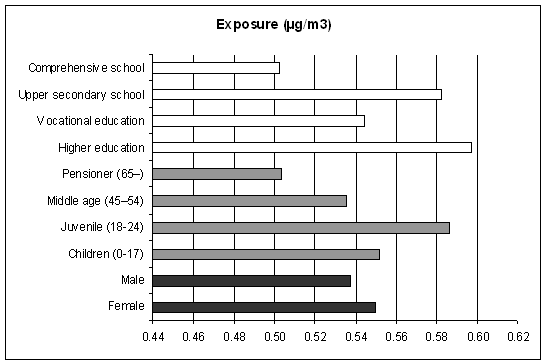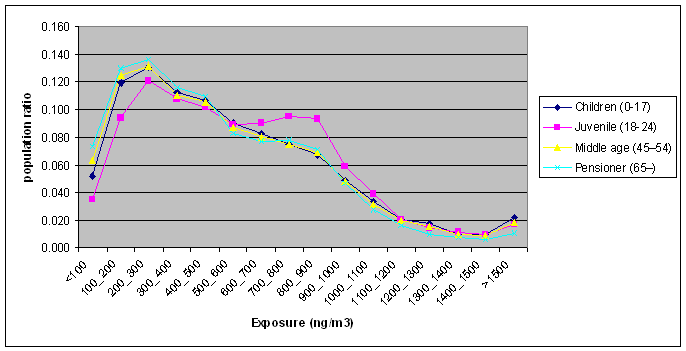Exposure of Finnish subpopulations to fine particles due domestic wood combustion
| Moderator:Pauliina (see all) |
|
|
| Upload data
|
- Analytica calculations can be found here.
- ArcMap based data of concentrations and age subpopulation can be found from N:\YTOS\Projects\BIOHER\Mallit\model of population groups\data\asuk05_koul04_resi00 .
Contents
Question
What is the exposure of Finnish subpopulations to PM2.5 due domestic wood combustion or traffic?
Result
More results and talk about the preresults is going on in Talk pageD↷.
Definition
This assessment is exploring the method and results of GIS (Geographical Information System) based exposure assessment of Finnish population. Exposure is evaluated for fine particles of domestic wood combustion emissions in Finland region. Concentration of PM2.5 (fine particles with aerodynamic diameter ≤ 2.5 µm) is used in exposure evaluation. In previous studies GIS has been used in evaluation of PM2.5 dispersion and assessment of exposure for PM2.5 (e.g. Tian et al 2004, Heinrich et al 2005, Brauer et al 2003). Intake fraction for Finnish population has evaluated to be 3.31 per million for fine particles due to domestic wood combustion emissions. In this assessment four different education and age groups in Finland are taken account to exposure evaluations for fine particles of domestic wood combustion. Differences between men and women exposure to fine particles are also studied.
Boundaries
- Exposure for fine particles PM2.5
- Population of Finland
- Male/female
- Age
- Education
Data
- Modeled dispersed concentrations of PM2.5 due domestic wood burning
PM2.5 emissions of domestic wood combustion in residential buildings were calculated with the Finnish Regional Emission Scenario (FRES) model of Finnish environment institute (Karvosenoja 2008) The dispersion model applied in this study was the urban dispersion modelling system developed at the Finnish Meteorological Institute (UDM-FMI). It includes a multiple source Gaussian plume model and a meteorological pre-processor MPP-FMI (Karppinen et al., 1997, 1998). Data of PM2.5 contained concentrations (ng/m3) with 1 km grid resolution.
- Data of Finnish population:
The population data for Finland was obtained from the Statistics Finland Grid Database (http://www.stat.fi/tup/ruututietokanta/index_en.html). The dataset contained population numbers for Finland on a resolution of 250 x 250 m2 for 2004 of different age groups and 2005 of different education groups, respectively (Table 1).
Table 1. Population of different education and age groups. Total population of Finland in year 2004.
| Population group | Total population |
| Comprehensive school | 1398225 |
| Upper secondary school | 325831 |
| Vocational education | 1793804 |
| Higher education | 570267 |
| Pensioner (65–) | 836977 |
| Middle age (45–54) | 763460 |
| Juvenile (18-24) | 453075 |
| Children (0-17) | 1094751 |
| Male | 2539492 |
| Female | 2664334 |
| Finnish total population | 5203826 |
Methodological issues
Data of dispersed concentrations were joined into population data with ArcMap version 9.2. [1] using nearest concentration points of each population grid. Product of population and concentration of each grid and sum of this product over Finland was calculated with ArcMap (see equation 1). Rest of calculations were implemented using Analytica ™ version 4.1. (Lumina Decision Systems, Inc., CA).
where Pop is the number of population in grid cell i (persons), i = 1,2, ..., n, n is the total number of grid cells in the study area, Ci is the concentration increase of PM2.5 in the grid cell i due to a specified emission source category or area of emissions (g/m3)and Poptot is total population of each subpopulations in Finland.
Fine particle concentrations was divided to 15 different divisions with ArcMap and total population in each concentration subdivision was counted with statistical computation and graphic system R version 2.7.0 (The R Foundation for Statistical Computing, http://www.r-project.org/).
Script for R. This is an example for under 100 ng/m3 concentration calculations. I hope that someone knows how to script this in shorter version. Otherwise I have to calculate all 11 concentration limitations separately.
Do someone knows how to make R to write table with column names and with several different vectors in the same table?


